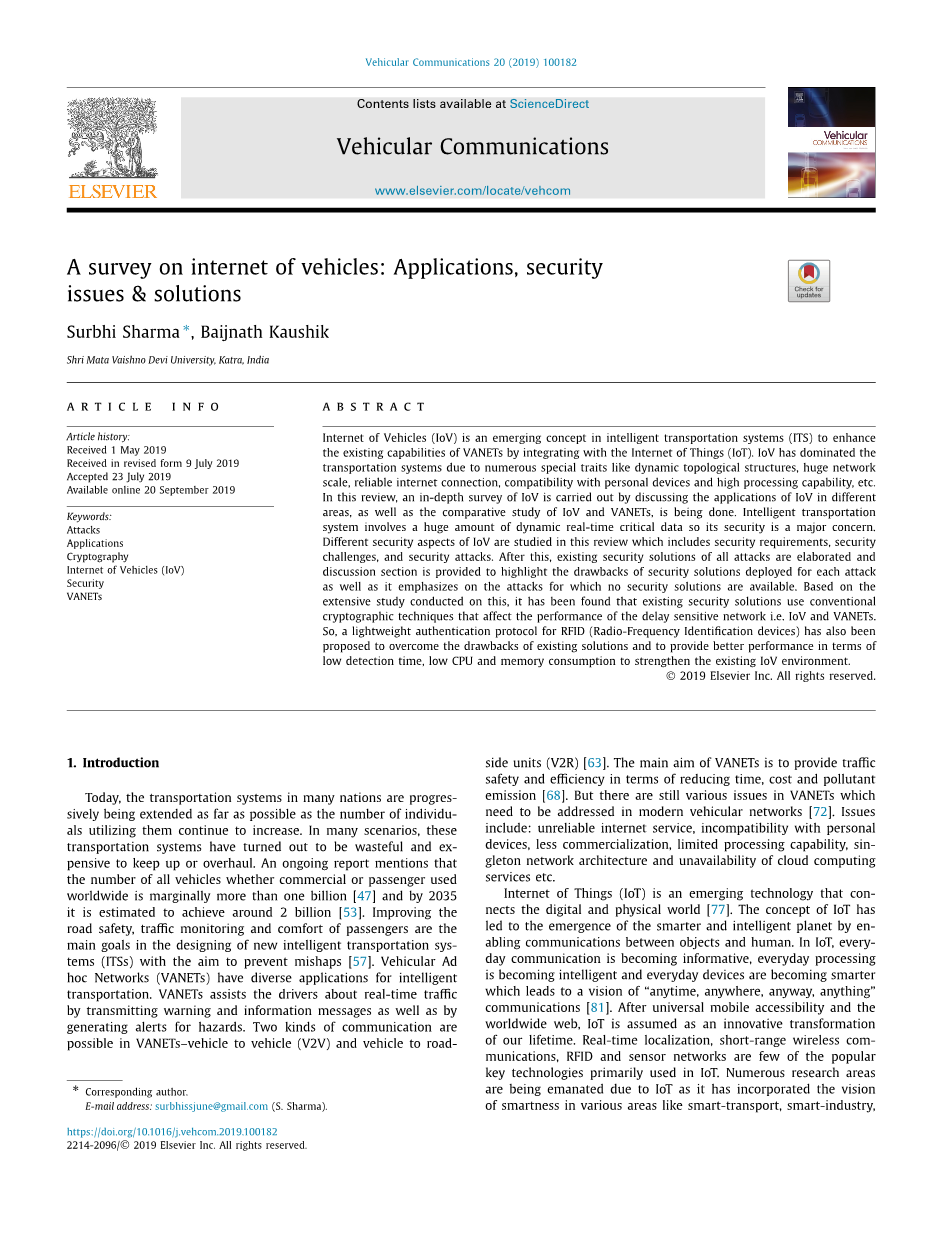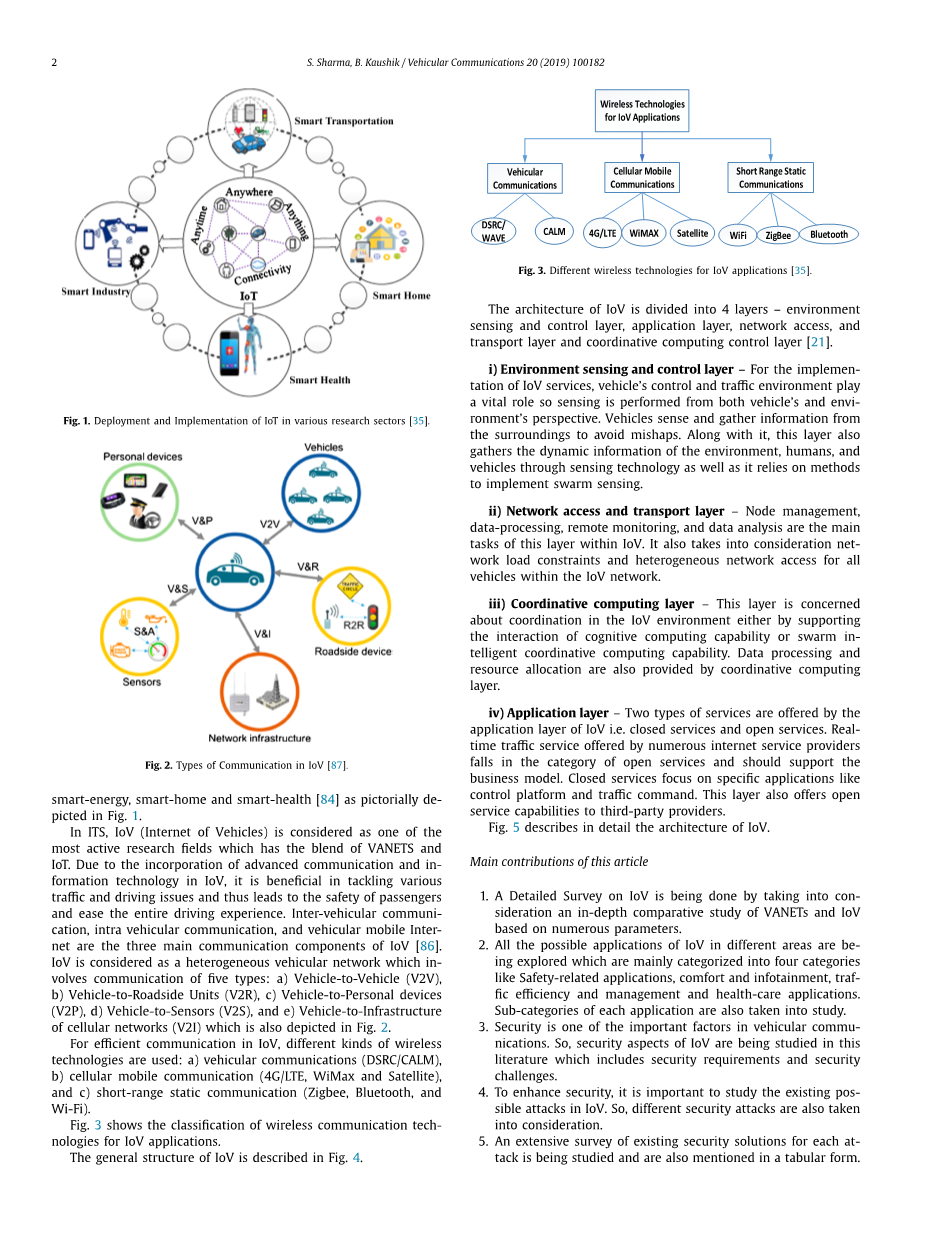

英语原文共 44 页,剩余内容已隐藏,支付完成后下载完整资料
原文1(节选)
A survey on internet of vehicles: Applications, security
issues amp; solutions
Surbhi Sharma lowast; , Baijnath Kaushik
Abstract: Internet of Vehicles (IoV) is an emerging concept in intelligent transportation systems (ITS) to enhance the existing capabilities of VANETs by integrating with the Internet of Things (IoT). IoV has dominated the transportation systems due to numerous special traits like dynamic topological structures, huge network scale, reliable internet connection, compatibility with personal devices and high processing capability, etc. In this review, an in-depth survey of IoV is carried out by discussing the applications of IoV in different areas, as well as the comparative study of IoV and VANETs, is being done. Intelligent transportation system involves a huge amount of dynamic real-time critical data so its security is a major concern. Different security aspects of IoV are studied in this review which includes security requirements, security challenges, and security attacks. After this, existing security solutions of all attacks are elaborated and discussion section is provided to highlight the drawbacks of security solutions deployed for each attack as well as it emphasizes on the attacks for which no security solutions are available. Based on the extensive study conducted on this, it has been found that existing security solutions use conventional cryptographic techniques that affect the performance of the delay sensitive network i.e. IoV and VANETs. So, a lightweight authentication protocol for RFID (Radio-Frequency Identification devices) has also been proposed to overcome the drawbacks of existing solutions and to provide better performance in terms of low detection time, low CPU and memory consumption to strengthen the existing IoV environment.
KEY WORDS: Attacks, Applications, Cryptography, Internet of Vehicles (IoV), Security, VANETs
- Introduction
Today the transportation systems in many nations are progressively being extended as far as possible as the number of individuals utilizing them continue to increase. In many scenarios, these transportation systems have turned out to be wasteful and expensive to keep up or overhaul. An ongoing report mentions that the number of all vehicles whether commercial or passenger used worldwide is marginally more than one billion [47] and by 2035 it is estimated to achieve around 2 billion [53]. Improving the road safety, traffic monitoring and comfort of passengers are the main goals in the designing of new intelligent transportation systems (ITSs) with the aim to prevent mishaps [57]. Vehicular Adhoc Networks (VANETs) have diverse applications for intelligent transportation. VANETs assists the drivers about real-time traffic by transmitting warning and information messages as well as by generating alerts for hazards. Two kinds of communication are possible in VANETs–vehicle to vehicle (V2V) and vehicle to road-side units (V2R) [63]. The main aim of VANETs is to provide traffic safety and efficiency in terms of reducing time, cost and pollutant emission [68]. But there are still various issues in VANETs which need to be addressed in modern vehicular networks [72]. Issues include: unreliable internet service, incompatibility with personal devices, less commercialization, limited processing capability, singleton network architecture and unavailability of cloud computing services etc. Internet of Things (IoT) is an emerging technology that connects the digital and physical world [77]. The concept of IoT hasled to the emergence of the smarter and intelligent planet by enabling communications between objects and human. In IoT, everyday communication is becoming informative, everyday processing is becoming intelligent and everyday devices are becoming smarter which leads to a vision of “anytime, anywhere, anyway, anything” communications [81]. After universal mobile accessibility and the worldwide web, IoT is assumed as an innovative transformation of our lifetime. Real-time localization, short-range wireless communications, RFID and sensor networks are few of the popular key technologies primarily used in IoT. Numerous research areas are being emanated due to IoT as it has incorporated the vision of smartness in various areas like smart-transport, smart-industry.
Motivation
VANETs have improved the transportation systems by enhancing the road safety and traffic efficiency but there are still various challenges that exist in VANETs which is not desirable in modern transportation systems. VANETs lacks the infotainment features like online video streaming, gaming, etc. which may hamper the driving experience and thus it have commercialization issues [88].
Along with this, other issues exist in VANETs like lack of compatibility support for personal devices i.e. tablets and phones [90], unreliable internet connectivity [99], storage and computing constraints [95], etc. Also, due to the increase in the number of traffic casualties, there is a need to incorporate smartness in vehicles, which give rise to the concept of IoV. IoV improves the existing issues of VANETs and is a better alternative for existing transportation systems. IoV is a new concept and is not yet fully explored. So, IoV needs to be explored from all the possible aspects before bringing it into actual deployment. Its possible application areas, as well as all the security issues and challenges associated with it, need to be identified. Various researchers across the globe are already working on the security aspects of IoV. So, it is very important to find the status and problems with the existing security solutions. So, in this research article, we have made a sincere attempt to find out these problems.
Section 2 discusses
剩余内容已隐藏,支付完成后下载完整资料
资料编号:[236879],资料为PDF文档或Word文档,PDF文档可免费转换为Word


